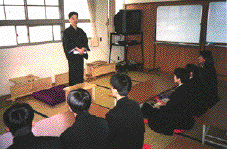 Science & Technology || Search || Back Numbers BRANCHING OUT:
 Students can now learn about traditinal arts straight from the masters. (Photo: Kyodo) Students in high schools across the nation are increasingly able to choose from a broad range of new, interesting subjects when planning their schedules. The schools are introducing these courses both out of consideration for their students' individuality and in order to foster people who can succeed in a rapidly diversifying society. Some of these students are graduating and starting to put their varied educations to work, although the newness and uniqueness of their courses of study can at times present them with obstacles as they move on in society.
Traditional Arts, Tourism, and the Environment
There are two divisions to this course, with a total of 40 students: one in classical arts like noh, kabuki, and kyogen (a form of comic drama performed during intermissions in noh plays); and one in comparatively modern forms, including rakugo and manzai, two types of comedic presentation. These courses of study have proved popular since their 1993 introduction, when over 100 people--2.55 for each slot--applied for admission. A third of the students' studies are in specialized classes covering art history; practice in the samisen, traditional Japanese dance, rakugo, and technical aspects of the stage arts; and the appreciation of other performing arts. The students spend time reciting lines from kyogen and kabuki plays, as well as tracing the lives of past stars of the film and music worlds. The instructors for both the practical and theoretical classes are all people currently at the forefront of the art world. Twenty-two professionals, including practitioners of rakugo and kyogen as well as television producers, take time from their busy schedules to act as guest lecturers for the length of the course. Working on what is close to a volunteer basis, these instructors name their desire to see young Japanese gain an understanding of their traditional culture as the prime reason for participating. So far this performing and cultural arts course has produced 77 graduates. Some have gone on to university and others to professional training colleges to deepen their understanding of their craft. Six alumni of the program have made it to the ranks of professional artists since graduation. The school has produced members of drama and kabuki troupes, disk jockeys, and even one graduate who is working part time while organizing a local acting group. Another prefectural school in Fukushima established an international tourism course three years ago in response to a regional need for people who could deal with foreign tourists visiting local sites. This spring the course graduated its first class, consisting of 37 people; nine of them have gone on to take jobs at hotels and inns in the region. A Wakayama prefectural school has introduced a semester system for its environmental studies course, established in 1993. The longer class times have enabled students to learn by taking more extended approaches to subjects and activities including whale watching. In describing their motives for joining the course, many students say that they "want to work to protect the environment, perhaps with a research organization"; others speak of their desire to work "not just in Japan, but to take part in United Nations or other international efforts to save the environment." All the alumni of this course have gone on to continue their studies at the college level.
Valuing Individuality A survey released in January by the Ministry of Education puts the number of "unusual" study courses available at the nation's high schools at 728. Those focusing on vocational studies run to 490; the remaining 238 cover specialized fields like music and the arts. In response to the progressing problems of the rapid aging of society, the need for internationalization, and environmental degradation, many courses of study touch on such topics as welfare, international affairs, and the environment. Many high schools have implemented elective systems where students are free to choose the classes they want to take; examples include a Kyoto prefectural school offering a course in the traditional culture of the ancient capital and a Gunma prefectural school that has established a course in natural environmental matters to give students specialized knowledge in that area. There are also moves to create entire schools focused on specialized studies, such as the Kyoto municipal magnet school, established this spring, where students receive in-depth individual musical instruction from specialists in the field. These courses all face a similar problem, however; many of their students can face barriers when they seek to continue their studies at university. These barriers spring from the fact that some of the core subjects needed for the standardized college entrance exams are replaced by the classes taken to satisfy the requirements of the specialty courses. There is heightened demand from these high schools for a system where they can recommend their students to colleges offering courses related to the students' fields of specialization.
 Edited by Japan Echo Inc. based on domestic Japanese news sources. Articles
presented here are offered for reference purposes and do not necessarily
represent the policy or views of the Japanese Government.
Edited by Japan Echo Inc. based on domestic Japanese news sources. Articles
presented here are offered for reference purposes and do not necessarily
represent the policy or views of the Japanese Government.
|
